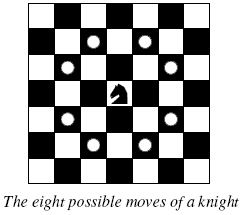Description
 Background
Background
The knight is getting bored of seeing the same black and white squares again and again and has decided to make a journey
around the world. Whenever a knight moves, it is two squares in one direction and one square perpendicular to this. The world of a knight is the chessboard he is living on. Our knight lives on a chessboard that has a smaller area than a regular 8 * 8 board, but it is still rectangular. Can you help this adventurous knight to make travel plans?
Problem
Find a path such that the knight visits every square once. The knight can start and end on any square of the board.
Input
The input begins with a positive integer n in the first line. The following lines contain n test cases. Each test case consists of a single line with two positive integers p and q, such that 1 <= p * q <= 26. This represents a p * q chessboard, where p describes how many different square numbers 1, . . . , p exist, q describes how many different square letters exist. These are the first q letters of the Latin alphabet: A, . . .
Output
The output for every scenario begins with a line containing "Scenario #i:", where i is the number of the scenario starting at 1. Then print a single line containing the lexicographically first path that visits all squares of the chessboard with knight moves followed by an empty line. The path should be given on a single line by concatenating the names of the visited squares. Each square name consists of a capital letter followed by a number.
If no such path exist, you should output impossible on a single line.
If no such path exist, you should output impossible on a single line.
Sample Input
3 1 1 2 3 4 3
Sample Output
Scenario #1: A1 Scenario #2: impossible Scenario #3: A1B3C1A2B4C2A3B1C3A4B2C4/*此题输出要按字典序。所以在深搜的时候有个小贪心。(注意看我的heng[] 和 zong[]数组) 此题p和q的上限是26.我一直以为是8 深搜的时候注意还原标记。 */ #include <iostream> #include <cstdio> #include <cstring> #include <string> using namespace std; bool vis[28][28]; bool flag=false; int A[1000][4]; int p,q; int heng[]={-1,1,-2,2,-2,2,-1,1}; int zong[]={-2,-2,-1,-1,1,1,2,2}; void dfs(int r,int c,int count) { count++; A[count][1]=r; A[count][2]=c; if(count==p*q) { flag=true; for(int i=1;i<=p*q;i++) { int r=A[i][1]; char c=A[i][2]+'A'-1; cout<<c<<r; } cout<<endl; } else { for(int i=0;i<8;i++) { int rr=r+heng[i]; int cc=c+zong[i]; if(((rr>=1&&rr<=p)&&(cc>=1&&cc<=q))&&((!vis[rr][cc]))) { vis[rr][cc]=1; dfs(rr,cc,count); vis[rr][cc]=0; if(flag) { break; } } } } } int main() { int t; scanf("%d",&t); for(int i=1;i<=t;i++) { flag=false; scanf("%d%d",&p,&q); memset(vis,0,sizeof(vis)); cout<<"Scenario #"<<i<<":"<<endl; for(int j=1;j<=p;j++) { for(int k=1;k<=q;k++) { memset(vis,0,sizeof(vis)); vis[j][k]=1; dfs(j,k,0); if(flag) break; } if(flag) break; } if(!flag) cout<<"impossible"<<endl; if(i!=t) cout<<endl; } return 0; }






















 802
802

 被折叠的 条评论
为什么被折叠?
被折叠的 条评论
为什么被折叠?








